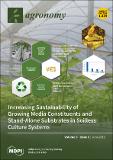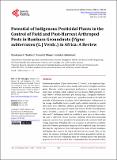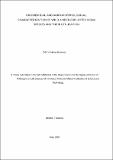| dc.description.abstract | The insu cient food supply due to low agricultural productivity and quality standards is
one of the major modern challenges of global agricultural food production. Advances in conventional
breeding and crop domestication have begun to mitigate this issue by increasing varieties and
generation of stress-resistant traits. Yet, very few species of legumes have been domesticated
and perceived as usable food/feed material, while various wild species remain unknown and
underexploited despite the critical global food demand. Besides the existence of a few domesticated
species, there is a bottleneck challenge of product acceptability by both farmers and consumers.
Therefore, this paper explores farmers’ perceptions, preferences, and the possible utilization of
some wild Vigna species of legumes toward their domestication and exploitation. Quantitative
and qualitative surveys were conducted in a mid-altitude agro-ecological zone (Arusha region)
and a high altitude agro-ecological zone (Kilimanjaro region) in Tanzania to obtain the opinions
of 150 farmers regarding wild legumes and their uses. The study showed that very few farmers
in the Arusha (28%) and Kilimanjaro (26%) regions were aware of wild legumes and their uses.
The study further revealed through binary logistic regression analysis that the prior knowledge of
wild legumes depended mainly on farmers’ location and not on their gender, age groups, education
level, or farming experience. From the experimental plot with 160 accessions of wild Vigna legumes
planted and grown up to near complete maturity, 74 accessions of wild Vigna legumes attracted the
interest of farmers who proposed various uses for each wild accession. A X2 test (likelihood ratio test)
revealed that the selection of preferred accessions depended on the farmers’ gender, location, and
farming experience. Based on their morphological characteristics (leaves, pods, seeds, and general
appearance), farmers perceived wild Vigna legumes as potentially useful resources that need the
attention of researchers. Specifically, wild Vigna legumes were perceived as human food, animal feed,
medicinal plants, soil enrichment material, and soil erosion-preventing materials. Therefore, it is
necessary for the scientific community to consider these lines of farmers’ suggestions before carrying
out further research on agronomic and nutritional characteristics toward the domestication of these
alien species for human exploitation and decision settings. | en_US |




